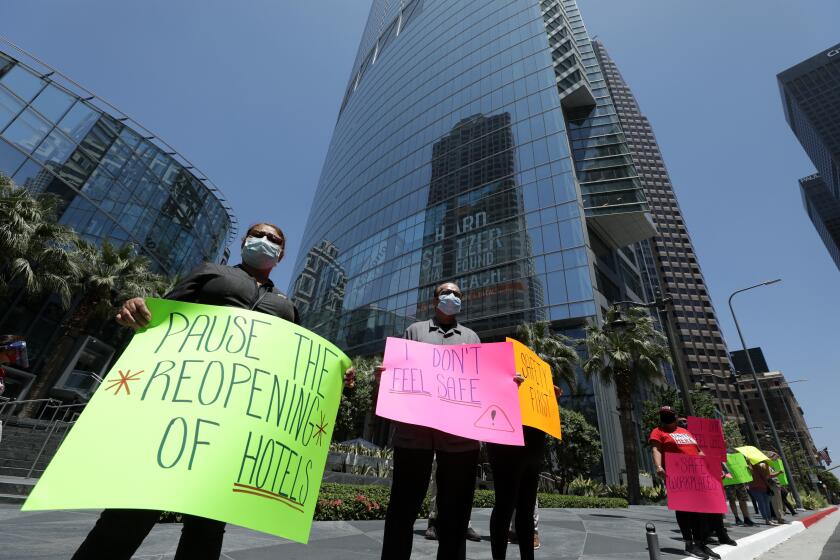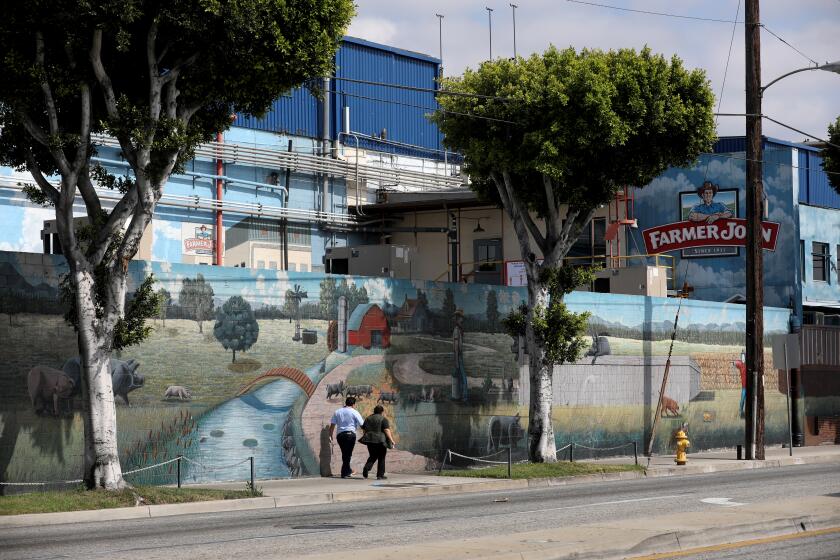California’s job growth slowed dramatically in July: August will likely be worse

California’s economic recovery slowed markedly last month as COVID-19 infections rose and the state resumed shutting businesses.
Employers added just 140,400 payroll jobs from mid-June to mid-July to a total workforce of nearly 15.8 million, state officials reported.
The July job gain was dramatically less than the record 542,500-job rise the previous month when some restaurants, gyms and other businesses briefly reopened amid hopes that the virus was abating.
California’s unemployment rate lowered to 13.3% last month, down from 14.9% in June. A year earlier, it stood at 4%.
Part of the decline in last month’s rate was due to a drop in people looking for work. In June, the state’s labor force expanded by 464,000 as many furloughed workers returned to their jobs. But last month it shrank by 167,000 as businesses closed again.
“July’s forward progress is welcome, but measured against historical benchmarks, the California labor market remains very much in the ICU,” said Scott Anderson, chief economist of Bank of the West in San Francisco.
Many, especially those backed by labor unions, push back against returning to their workplaces, citing employers’ failures to prevent COVID-19 outbreaks.
Los Angeles County’s economic picture was particularly dire, with a July jobless rate of 17.5%, down from 19.4% in June. A year earlier, it was 4.4%.
Many of Southern California’s tourist-dependent industries, including hotels, restaurants and theme parks, remain closed, while many Northern California technology firms continued to thrive thanks to remote working, online shopping and digital streaming, economists say.
For the week that ended Aug. 15, California’s new unemployment claims fell to their lowest level in five months, with 201,600 applications submitted to the state Employment Development Department. But 4.8 million Californians were still collecting jobless benefits.
A federal supplement of $600 a week expired at the end of July. That’s expected to push more Californians to seek work this month, said Michael Bernick, a former EDD director.
“California’s local workforce boards and employment agencies are reporting an increase in job applicants,” he said. “But with the economic lockdowns, the jobs are not coming back in any significant numbers.
“In fact, the opposite is occurring. California businesses continue to announce that they are closing permanently. Any economic recovery we saw in June and early July has stalled, and a listlessness set in.”
The U.S. jobless rate of 10.2% was significantly lower than California’s in July, and the nation’s payrolls grew more than California’s: 1.3%, as compared with 0.9%.
The comparatively better national picture reflects the fact that many other states have either succeeded in tamping down the spread of the coronavirus or have been reluctant to close businesses despite high infection rates.
California Gov. Gavin Newsom defended his reopening decisions and adopted the same argument made by many critics of his original order: The consequences of the COVID-19 shutdown for the economy and mental health were too great to ignore.
Over the last three months, California has regained less than a third of the 2.6 million positions lost during March and April as the pandemic took hold.
And the state’s jobless rate remains a percentage point higher than its 12.3% peak during the Great Recession.
As of Friday morning, California had reported more than 653,000 cases of COVID-19 and more than 11,800 deaths.
“Difficult times remain ahead,” said Lynn Reaser, an economist at San Diego’s Point Loma Nazarene University. “Forty-two of California’s 58 counties are currently on the state’s COVID-19 watchlist, which means bans on a significant number of indoor activities, including gyms, restaurant dine-in service, museums, indoor malls and hair salons. People also remain cautious about venturing out.”
Small businesses face cash flow crises as an extension of the federal Paycheck Protection Program loan program remains in limbo. “PPP was intended to provide a bridge for businesses to get to the ‘other side,’” Reaser said. “But the distance to the other side has turned out to be much longer than expected.”
Meanwhile, negotiations have stalled between the Trump administration and congressional Democrats who propose a trillion-dollar stimulus for state and local governments as tax revenues drop and safety net expenses rise.
The bill passed by the Democratic-led House would also extend the $600 weekly unemployment supplement through the end of the year, but it has been blocked by the Republican-led Senate and the White House.
This week California applied for a stopgap $300 weekly jobless payment to be drawn from federal disaster funds, under an executive order issued by President Trump on Aug. 8.
But the supplement is expected to last just a few weeks. It applies only to workers earning at least $100 in state unemployment benefits, thus excluding many low-income part-timers who have lost jobs.
“The end of the federal stimulus will have a big impact on California,” said Sung Won Sohn, a Loyola Marymount University economist. “It accounted for about 20% of personal income nationwide and allowed consumers to pay rent and buy food. Many small businesses may not survive.”
L.A. County’s contact-tracing system has repeatedly failed to alert officials to outbreaks at workplaces, allowing COVID-19 to continue to spread.
Statewide, nine of California’s 11 industry sectors gained jobs last month. Trade, transportation, and utilities had the largest job increase (40,900) because of motor vehicle and professional equipment wholesalers, as well as automobile dealers.
Construction lost 14,800 jobs, the largest drop in any sector, because of weak hiring in residential building despite a rise in commercial construction.
As its unemployment rate dipped slightly, Los Angeles County’s payrolls dropped by 3,600 jobs to 4,093,500. County employment was down 9.4% over the year, with leisure and hospitality jobs plummeting 30%.
In Orange County, joblessness stood at 12.3%, down from 13.6% in June, and from 3.1% a year earlier. July payrolls dropped by 17,700 jobs, to 1,464,500.
In the Inland Empire, the unemployment rate was 13.4%, down from 14.3% in June and 4.6% a year earlier. Payrolls in the region, encompassing Riverside and San Bernardino counties, shrank by 8,000 jobs last month to 1,385,400.
State employment numbers are based on a monthly federal survey of 5,100 California households that focuses on workers. Payroll estimates come from a second survey of about 80,000 California businesses.
If economists are doubtful that July’s job report offers much hope, they are even more pessimistic about the direction of the California economy in August.
“The July numbers probably paint a brighter picture of the California labor market than what actually occurred,” Anderson said, noting that Gov. Gavin Newsom ordered more business shutdowns in mid-July “so new layoffs from that likely won’t show up in the data until the August payroll report is released in September.”
California’s economic recovery will depend on whether the federal government can enact more stimulus measures, including unemployment benefits, and on curbing the COVID-19 infection rate, said David Smith, an economist at Pepperdine Graziadio Business School.
“It looks like a long road ahead where we are going to have to punch, kick and crawl our way back to anything near historically normal employment,” he added.
But beyond funding the social safety net, any economic resurgence is linked to the behavior of individual Californians, state officials say. It “depends on Californians choosing to wear face masks, staying at home when possible, and following state and local guidance” on coronavirus measures, California Labor Secretary Julie Su said in a statement on the jobs report.
More to Read
Inside the business of entertainment
The Wide Shot brings you news, analysis and insights on everything from streaming wars to production — and what it all means for the future.
You may occasionally receive promotional content from the Los Angeles Times.













